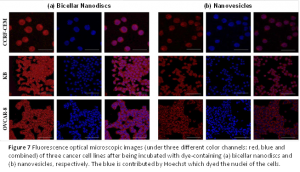Interaction between Polymers And Lipids
- Scientific Significance: On biological membranes, hydrophobic/hydrophilic interaction is one of the most important parameters in controlling the membrane morphology. The interaction between simple amphiphilic macromolecules (e.g., block copolymers) and lipid NPs can provide important implication for some biological functions. The on-demand aggregating process can also be used as a platform for signal amplification.

- Applications:Biosensing, on-demand drug delivery.
Strung Lipid NPs:
We are able to “string” nanodiscs and nanovesi
cles together into clusters through an amphiphilic triblock copolymer as shown in Fig 9 (a nega
tively-stained TEM micrograph by Ying Liu). The formation of such shish-kebab structure is a result of hydrophobic-hydrophilic interaction. This research focuses on two aspects: (1) identification of the controlling parameters for final morphology of the “strung” NPs and (2) understanding of the clustering kinetics of the spontaneous “stringing” process.
Instrument-Free, High-Sensitivity Biosensing:
The principle of on-demand clustering process can be applied to detect pathogens, virus, biomarkers and toxins with high sensitivity. The strategy is to cluster the NPs containing dyes around the targets (e.g., pathogens) until visible-sized aggregations form. Samples of four different E-coli H157:O7 pathogen concentrations (i.e., 108, 106, 10
2 and 0 CFU/mL) were examined by anchoring E-coli H157:O7 pathogens on the glass slides, followedby clustering the targeting and Nile-Red containing NPs around the anchored pathogens through polymer/lipid interaction. As a result, the strung-NP clusters would cling to the substrate in presence of pathogens. Fig 10 (taken by Yan Xia) shows that the glass slides of all except for pathogen-free samples are covered by red NPs in full length, while the NP clusters precipitate at the bottom of vial for pathogen-free sample indicative of a promising platform for instrument-free, high-sensitivity pathogen detection.